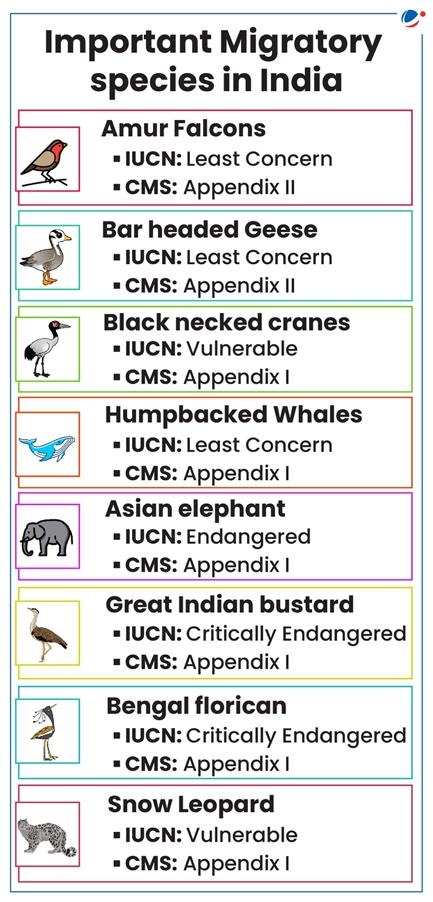Why in the News?
The Fourteenth Meeting of the Conference of the Parties to the Convention on the Conservation of Migratory Species of Wild Animals (CMS COP 14) held in Samarkand, Uzbekistan.
About Convention on the Conservation of Migratory Species of Wild Animals (CMS) or Bonn Convention.
India and CMS
|
State of the World’s Migratory Species
|
About CMS COP 14
- Conference of Parties (COP) to Convention on the Conservation of Migratory Species:
- It is the principal decision-making body of the Convention.
- It meets once every 3 years and sets the budget and priorities of the following three years.
- It also decides on the amendment of the Appendices and considers reports submitted by the Parties.
- Key-outcomes:
- A host of new measures to safeguard migratory species have been adopted.
- Slogan: "Nature knows no borders"
- Addition of 14 species to Conservation of Migratory Species (CMS) Appendices including Eurasian Lynx, Pallas's Cat and Sand Tiger Shark etc.
- New Concerted Actions: For six species, including Chimpanzee, Straw-colored Fruit Bat, and Blue Shark etc.
- Single Species Action Plans (SSAPs): for aquatic species, such as the Atlantic Humpback Dolphin, the Hawksbill Turtle and the Angelshark.
- Agreement on Central Asian Flyway (CAF): Spanning 30 Range States of migratory birds. It includes the establishment of a coordinating unit in India.
- Global Partnership on Ecological Connectivity (GPEC) was launched.
- It aims to ensure that ecological connectivity is maintained, enhanced, and restored in critical areas for migratory species.
About Migratory Species
- Definition: A species of wild animals of which the entire population or any geographically separate part of the population cyclically and predictably cross one or more national jurisdictional boundaries.
- The word 'cyclically' relates to a cycle of any nature, such as astronomical (circadian, annual etc.), life or climatic, and of any frequency.
- The word 'predictably' implies that a phenomenon can be anticipated to recur in a given set of circumstances, though not necessarily regularly in time.
Initiative taken in India to conserve Migratory Species
|

Way Forward
- Protect, connect and restore habitats: Need to identify critical habitats and sites for e.g., Key Biodiversity Areas (KBAs).
- Tackle overexploitation: For e.g., implementation of the new Biodiversity Beyond National Jurisdiction (BBNJ) Treaty (sets up a procedure to establish large-scale marine protected areas in the high seas)
- Reduce the damaging impacts of environmental pollution: Adoption of light pollution mitigation strategies, restrict the emission of underwater noise for marine species, phase-out of toxic lead ammunition, tackle the issue of plastic pollution etc.
- Address the root causes and cross-cutting impacts of climate change: Help migratory species adapt to a changing climate through targeted ecosystem restoration efforts. For e.g., Kunming Declaration.
- Ensure the CMS Appendices protect all migratory species in need of further conservation action:
- Consider migratory species threatened with extinction not yet listed in CMS.
- Prioritize research on ‘Data Deficient’ migratory species.



